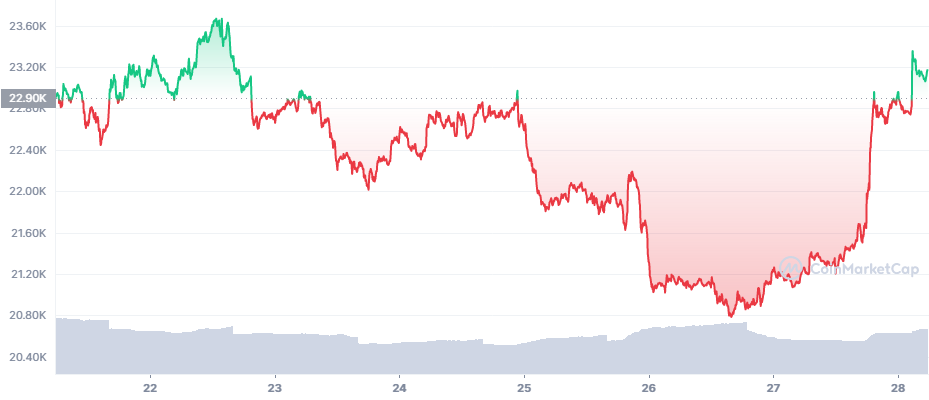Bitcoin (BTC) Reacts Positively After FOMC Meeting

Bitcoin (BTC) retained its volatile behavior, but this time rallied above $23,000 within hours, starting the climb late on Wednesday. The US Fed voted on another 0.75% rate hike, which this time did not work to bring down BTC. The last time the Fed started to raise interest rates, BTC slid from its position, but this time shorting was even riskier.
BTC traded at $23,129.53, extending the mid-week recovery. This time, the expansion happened on more subdued trading volumes of $28B in the past 24 hours. BTC also had a speedy recovery from a recent dip closer to $20,000.
In the long term, BTC is seen as a hedge against inflation. However, the current shift in US Fed and European Central Bank interest rate policies may change the appeal of BTC. The highly volatile price also erased value, and in the past BTC has seen dips of 85% before recovery.
One of the reasons for a rally instead of a dip is that the 0.75% hike was predictable and already affected the markets. The Fed has now added 225 basis points to its interest rate, taking it to the 2.25%-2.5% level. With the series of hikes this year, the rate is neutral to official inflation and remains relatively low, similar to the temporary rate hikes before 2018. BTC has still traded upward in a tightening interest rate cycle, though this time there may be less freely available funds to expand the price action.
For now, BTC seems to have completed the sell-off and capitulation, returning to accumulation and another relief rally.
But the rallies still stall without breaking to a higher price range, remaining risky for leveraged traders with both long and short positions. The sudden hike above $22,000 out of a lower range led to $75.78M in liquidations in the past 24 hours based on Bybit data. The liquidations of BTC come on the tails of Ethereum (ETH) liquidations, which mostly affected long positions.
BTC Still Goes for Bear Market Patterns
The recent relief rally is not unusual, and BTC may not behave predictably. The bullish scenario would be a breakout from the descending wedge. However, BTC is still outside the range for an immediate larger rally.
What could follow is a breakout that is cut short by other factors, or runs out of steam. BTC still trades below its usual volumes, creating risky short-term rallies.
ETH Goes for Stronger Recovery
ETH added 12% from Wednesday’s lows, rising above $1,550 with ease. The current range is establishing ETH and all DeFi protocols for relative stability. ETH is also not as closely watched for the direction of the markets, as BTC still sets the pace.
The recent rally also affected Uniswap (UNI), with the token recovering to 7.49, up 18% in the past 24 hours and with a big hourly gain above 7%.
Uniswap still depends on ETH for liquidity and benefits from the recovery. The immediate reason is that UNI has been listed to the Blockchain wallet, making the token more accessible.
Uniswap has also proven to be one of the more successful DEX on Ethereum, after many attempts to build automated trading. The exchange also migrated to the Optimistic ecosystem, avoiding too high ETH fees on each swap.
Will Celsius Still Affect the Markets
The bankruptcy announcement of Celsius has mostly been absorbed by the markets, not extending the shocks. But the fallout affects trading in unexpected ways.
CEL, the native token of the failed fund, rallied rapidly to $1.10 reached within hours. CEL is now near a one-month high, showing signs of a short squeeze. This makes CEL even riskier to short positions, as most were liquidated during the latest hike.
Most of the CEL activity happens on the FTX exchange, where 38% of all trading is concentrated. Because all CEL assets are frozen, there is a scarcity of available tokens. This creates demand for CEL to cover short positions, in case the price breaks out.
CEL is also suitable for short-term manipulation, precisely to liquidate short positions. The short squeeze may also become a social media trend, accelerating the price rally.
There is also a call to take CEL off exchanges to create scarcity in exchange-based wallets, making it more expensive to cover short positions. CEL has resisted going below $0.90, which would benefit the holders of short positions. Exchanges with smaller CEL reserves are at risk, including OKEx, Gate.IO, as well as decentralized markets like Uniswap. However, a CEL rally does not make the asset a good investment and the price may turn down without warning.

Uphold makes buying crypto with popular currencies like USD, EUR and GBP very simple with its convenient options to swap between crypto, fiat, equities, and precious metals.

With over 50 coins and an obsession with security, Kraken is one of the safest places to buy and trade crypto.

Kraken has a good reputation for security and protection of your funds and operates across the USA (except NY), Canada, the EU and Japan

Based in Charleston, South Carolina. Serves over 184 countries and has done over $4 billion in transactions. Offers convenient options to swap between crypto, fiat, equities, and precious metals.

How do cryptocurrencies stack up against popular stocks and shares?

What is cryptocurency? What gives it value? How do you buy and store it? Beginners questions answered in plain English.

An early alternative to Bitcoin, LTC aimed to be a coin for easy, fast, low-fee spending. LTC offers a faster block time and a higher transaction capacity in comparison to Bitcoin.

The leader in programmable money, smart contracts and decentralised applications. There have been many copycats but none have the community and level of adoption.